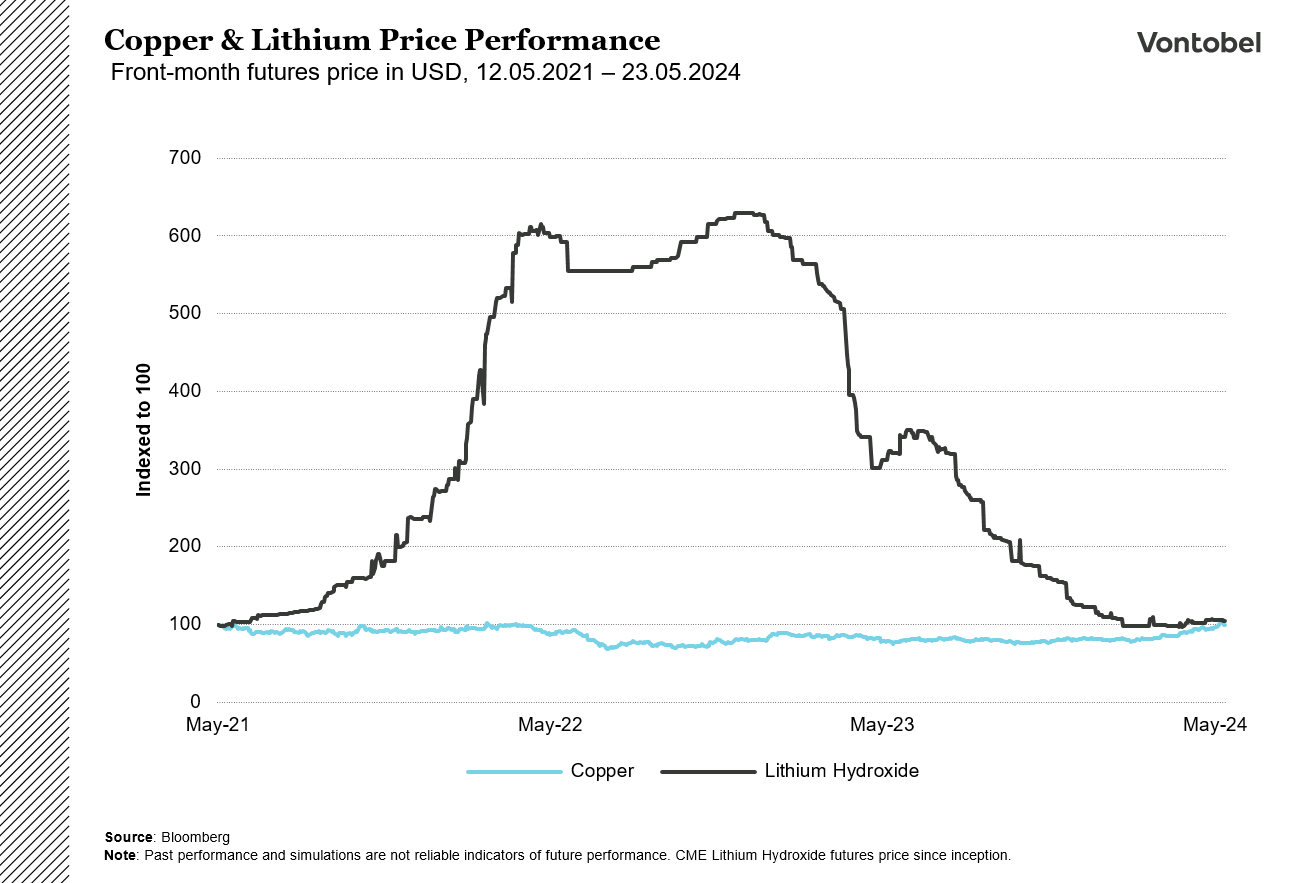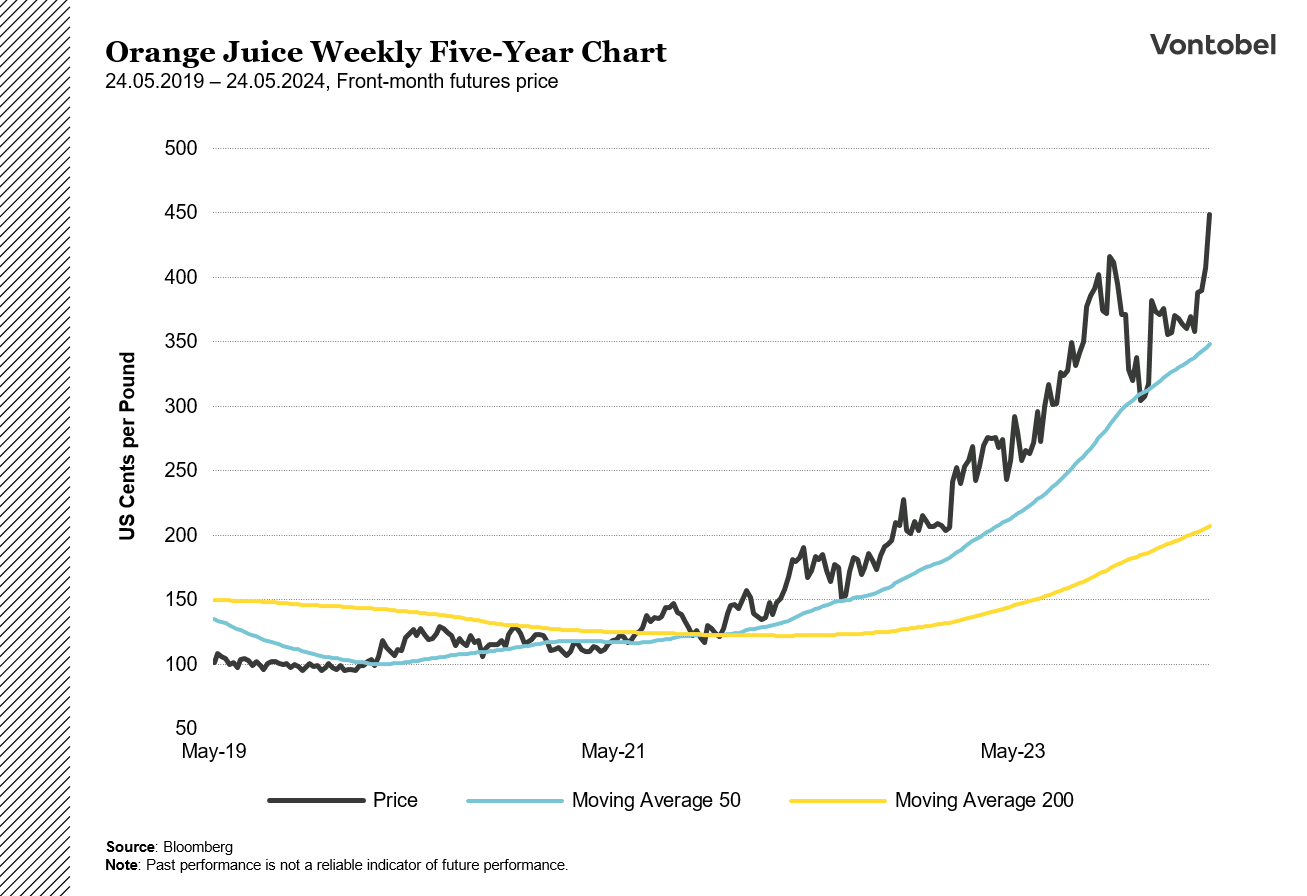Bi-weekly Commodity Insight

Metal prices have got the newspapers buzzing, to say the least. New highs in copper, a key component of electronics and a leading indicator of inflation, among others, are raising concerns for central banks around the world. We also look at the white metal silver, as well as orange juice, where producers continue to battle plant diseases.
Headwinds for central banks
The copper futures price traded at an all-time high during week 21, with prices reaching USD 10,915/tonne on the London Metal Exchange. The price rally comes as a result of increased optimism for the manufacturing sector and weak supply for the red metal nicknamed Dr Copper. The metal's nickname is a reference to its ability to gauge the health of the economy, while its price rally also could create headaches for central banks dealing with high inflation.

That copper has structural tailwinds hardly needs mentioning. The metal is the second-best electrical conductor after silver, but costs only one-sixth of the price of silver, making copper the obvious choice for the vast majority of applications in the electrification of society. Demand for copper is expected to grow strongly over the coming decades because of the green transition and the general electrification of society. According to intelligence firm S&P Global, demand for the metal is expected to reach 49 million tonnes in 2035, which compares to 2021 demand of 25 million tonnes.

At the same time, investors are questioning whether the sharp rise in copper prices is reasonable. The Yangshan copper premium, which is the premium Chinese traders pay for imported copper above London Metal Exchange reference prices, fell into negative territory for the first time in April. The negative premiums indicate that demand in China, the market's biggest player, is subdued. Sceptics also point to the lithium price. The price of lithium was inflated in 2022 in the hope of increased demand due to the electrification of society (similar reasons driving today's copper price), only to fall flat in 2023.

The white metal passes 30
Like copper, and indeed many other metals, silver has seen its price soar. The silver price recently crossed USD 30/oz for the first time since 2013, an 11-year high. The reason? There are several, but a major factor behind the recent price surge is the scarcity of the metal. While the AI revolution and the electrification of society are fueling demand for electrical conductors (silver being the best), supply is not keeping up.

Silver is one of the best performing commodities in 2024, but what will drive the price going forward? One possible trigger could be the interest rate cuts lurking on the horizon. Sweden's and Switzerland's central banks have each started with a first interest rate cut. The market expects cuts by the ECB in June and the Fed in September or November. With lower rates ahead, bonds may look less attractive, possibly incentivizing a rotation into precious metals. At the same time, the likelihood of interest rate cuts has decreased. At the beginning of 2024, the market was pricing in three cuts from the Fed in 2024, compared to one cut today. The rising copper price also suggests that higher inflation is to be expected, which is not exactly in favor of those hoping for a more dovish FED.

Worst harvest in 36 years
We return once again to the perhaps slightly odd commodity orange juice. Since we last wrote about the commodity, conditions in the orange orchards seem to have only worsened. The top producer of orange juice, Brazil, is heading for its worst orange harvest in 36 years. According to analyst firm Fundecitrus, Brazil is expected to produce only 232.4 million 40.8kg boxes of oranges in the 2024/2025 season, down 24 per cent from the season before.

Extreme heat in the autumn of 2023 damaged the orange trees during a period of flowering, which has had a negative impact on the harvest. At the same time, the yellow dragon disease continues to wreak havoc on the orchards, which do not yet have a cure. As a result, prices have continued northwards, with orange juice trading at 469 US cents/pound as of May 23d. The most important trigger to watch for is if a possible cure for citrus greening is found, which would likely bring the price down.

Risks
Disclaimer:
This information is neither an investment advice nor an investment or investment strategy recommendation, but advertisement. The complete information on the trading products (securities) mentioned herein, in particular the structure and risks associated with an investment, are described in the base prospectus, together with any supplements, as well as the final terms. The base prospectus and final terms constitute the solely binding sales documents for the securities and are available under the product links. It is recommended that potential investors read these documents before making any investment decision. The documents and the key information document are published on the website of the issuer, Vontobel Financial Products GmbH, Bockenheimer Landstrasse 24, 60323 Frankfurt am Main, Germany, on prospectus.vontobel.com and are available from the issuer free of charge. The approval of the prospectus should not be understood as an endorsement of the securities. The securities are products that are not simple and may be difficult to understand. This information includes or relates to figures of past performance. Past performance is not a reliable indicator of future performance.
© Bank Vontobel Europe AG and/or its affiliates. All rights reserved.
Credit risk of the issuer:
Investors in the products are exposed to the risk that the Issuer or the Guarantor may not be able to meet its obligations under the products. A total loss of the invested capital is possible. The products are not subject to any deposit protection.
Market risk:
The value of the products can fall significantly below the purchase price due to changes in market factors, especially if the value of the underlying asset falls. The products are not capital-protected
Risk with leverage products:
Due to the leverage effect, there is an increased risk of loss (risk of total loss) with leverage products, e.g. Bull & Bear Certificates, Warrants and Mini Futures.
Product costs:
Product and possible financing costs reduce the value of the products.
Currency risk:
If the product currency differs from the currency of the underlying asset, the value of a product will also depend on the exchange rate between the respective currencies. As a result, the value of a product can fluctuate significantly.
